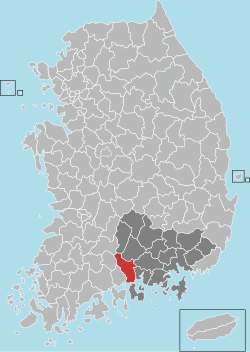Top Qs
Timeline
Chat
Perspective
Hadong County
County in Yeongnam, South Korea From Wikipedia, the free encyclopedia
Remove ads
Hadong County (Korean: 하동군; RR: Hadong-gun) is a county in South Gyeongsang Province, South Korea. It is located on the far-west side of the province, bordering South Jeolla Province. The county office is located at Hadeong-eup.
Remove ads
History
Summarize
Perspective
Hadong was originally called Dasachon (다사촌; 大沙县, "county of much sand") when it was a part of the Jin state. It later became part of Nangnoguk (낙노국; 樂奴國), one of the Byeonhan confederacy's twelve statelets. According to the History of the Three Kingdoms, the region was called Handasa-gun (한다사군) before changing into Hadong-gun in 757 CE during the reign of King Gyeongdeok of Silla. During the Goryeo dynasty, the area was known as Hadong-hyeon (하동현). Amid the reign of the Joseon-era King Taejong in 1414, it became known as Hanamhyeon (하남현) with Namhaehyeon (남해현). In 1702, Agyang-myeon was added to Hadong-gun. Hadong was raised to the status of Hadongdohobu (하동도호부) in 1740, the thirtieth year of King Sukjong's reign.[2]
On April 1, 1914, Seo-myeon (서면) and Geumyang-myeon (금양면) were added to Hadong. Part of Seomjin-ri (섬진리), Daap-myeon (다압면), and Gwangyang-gun of South Jeolla Province were added to Hadong on January 1, 1915. In 1917, Naehoengbo-myeon (내횡보면) was renamed to Hoengcheon-myeon (횡천면) while Deokyang-myeon (덕양면) was renamed to Jingyo-myeon (진교면). Geumyang-myeon (금양면) was abolished and incorporated into Jingyo-myeon (진교면) and Geumnam-myeon (금남면), formerly Nam-myeon (남면), on January 1, 1933. On October 1, 1938, Hadong-myeon (하동면) was elevated to Hadong-eup (하동읍).
During the Korean War, the region was the site of the Hadong Ambush, a North Korean attack on US Army forces.
Remove ads
Local sights and attractions
Nestled between the Seomjin River and Mount Jiri, the county is a popular destination for both domestic and foreign tourists who enjoy nature.[3] Portions of the Jirisan National Park lie within the county, forming the county's hilly, mountainous landscape.[4]
The Ssanggyesa is a historic Korean Buddhist temple of the Jogye Order that has been designated a National Treasure.
Pak Gyeongni's 16-volume novel Land is partially set in the village of Pyeongsa-ri (평사리) in Agyang-myeon, Hadong County. A replica of the fictional Choi family's home was built there to commemorate the author's legacy.[3][5]
Green tea
Hadong has been famous for its green tea since the Silla era when an envoy brought green tea seeds from the Tang Empire to be planted locally.[3] The local government has long promoted this as a major local attraction, including sponsoring a tourism advertisement that aired on CNN in 2007.[6] The annual "wild tea" festival, lasting 25 days, takes place during May and June.[3][4]
Remove ads
Development
While much of South Korea has experienced rapid industrial development, Hadong remains a destination for those wishing to escape the bustle of city living.[original research?] However, a lack of industrial sector activity has left the government with little incentive to expand the sometimes inadequate existing road infrastructure.[original research?] A petition for the allocation of funds for new road construction was signed by a number of Hadong residents.[7]
Former South Korean president Lee Myung-bak has recently[when?] announced plans for the construction of a Gyeongsangnam-do leisure resort palace in Hadong.[8]
Notable people
- Jeong Gi-ryong
- Yi Byeong-ju, a novelist, journalist, and reporter
- Jeong Ho-seung
- Kang Man-soo
- Jeong Gongchae, a poet who won the 1960 Contemporary Literature (Hyundae Munhak) Award[9]
Schools
- Agyang Middle School
Twin towns – sister cities
Hadong is twinned with:
 Anyang, South Korea
Anyang, South Korea Gwangyang, South Korea
Gwangyang, South Korea Geoje, South Korea
Geoje, South Korea Seongdong-gu, South Korea
Seongdong-gu, South Korea Haeundae-gu, South Korea
Haeundae-gu, South Korea Zhangqiu, China
Zhangqiu, China Ya'an, China
Ya'an, China Zhangjiajie, China
Zhangjiajie, China
References
External links
Wikiwand - on
Seamless Wikipedia browsing. On steroids.
Remove ads



